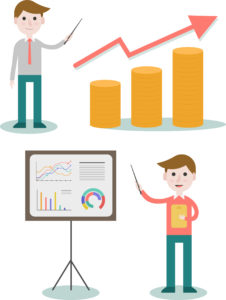Approaching data analysis: How to interpret data? – Beginners Guide
With more and more companies using big data, demand for professional data analysts has witnessed exponential growth in the recent years.
“Learners of data analysis and interpretation need to have an in-depth understanding of the subject along with the statistical acumen and working knowledge of tool sets to make significant progress in the field of data analytics” – Dr. Venkatesh, Statistician.
To gain good expertise in Data analysis and interpretation, the beginner learner requires good foundation in basic statistics, and better skills of how to input, process and analyze data by employing a range of data analytical and visualization tools.
The objectives of data analysis and interpretation are to manipulate the data, both qualitative as well as quantitative, to obtain utilizable information that is critical to making informed decisions. It involves the usage of many different methods and procedures that can,
- Describe and summarize data
- Evaluate and enhance quality of data
- Break a macro problem into micro parts for the easy understanding and problem solving
- Understand the relationships between different variables (independent and dependent)
- Facilitate comparison of variables
- Identify the difference between the variables (e.g. Ordinal, nominal, categorical)
- Evaluate impact or the significance (e.g. Clinical/meaningful in a real time and Statistical)
- Forecast possible outcomes
1. Data Analysis in Research
Research is an important tool to discover new events and understands new phenomena and the Data analysis in the research facilitates the researcher to structure the results from survey research and allows the researcher to reach a conclusion. The purpose of the data analysis in research studies is to find answers to the research question and to facilitate the researcher to determine the trends and inter-relationship of different variables included in the study.

Data analysis in research methodology refers to a variety of specific procedures and methods used in the manipulation of the research data to obtain logical inferences. Important stages of data analysis include
- Data Cleaning and preparation
- Descriptive analysis of data
- Statistical models and test of hypothesis
A beginner in the field of Data Analytics needs to develop a good understanding of the qualitative and quantitative data, their important differences and the various methods used in their analysis. Qualitative research study uses tools like interviews surveys, focus groups and experiments to collect important data for the study and their analysis process involves recognizing common patterns within the responses to achieve research objectives.
Data analysis in quantitative research studies involves the process of critically analyzing and interpreting figures and numbers, with the purpose of obtaining the underlying principle behind the emergence of principal findings of the study.
2. Data Interpretation
Interpretation of Data analysis research forms the critical feature of the research report and is often considered the most difficult section in research writing because of its least structured nature.

Data interpretation is the process of putting together specific meaning to the data, as mere data themselves do not carry and convey any importance to the decision-making process.
“Beginners in the discipline of data analysis and interpretation need to understand that often the same set of data can have different interpretations. Interpretation of data necessitates fair and careful judgments from the data interpreters to arrive at the valid and meaningful information from the available data” – Dr. Venkatesh, Statistician.
Important skills of Data interpretation for beginners include
- Proficiency in mathematical reasoning
- Ability to see bigger picture
- Competency in interpreting numerical data and non-numerical data like texts and images
- Sufficient working knowledge of data visualization tools
- Domain specific knowledge (e.g. Healthcare, Regulatory, Finance)
Overall, an effective Data analysis and interpretation in research methodology require the budding researchers to possess creativeness and perceptiveness to integrate the findings of the study in both theory and application relating to the method, unexpected results, and finally considering the limitations of the research study.

